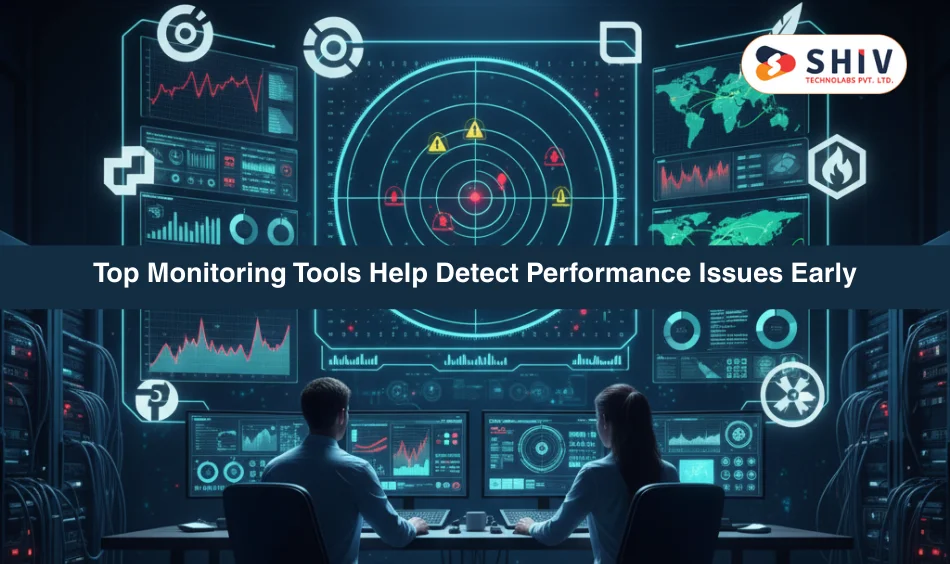Table of Contents
Once your application begins to slow down, crash with traffic, or respond inconsistently, the problem lies in the backend. It does not matter to Smooth UI when your servers, APIs, and database cannot meet. This is where backend development services play an important role in determining fast app loading time, impressive scaling, and reliability during peak traffic on the website.
If anytime you wonder why a well-designed app still annoys users, it’s not the aesthetic appeal but the answer lies within the backend in APIs, database queries, server load, caching mechanisms, and deployment architecture.
Keep reading the article, as here we will cover the approach to backend development and how it addresses performance issues and improves speed.
What Causes App Performance Issues in Modern Applications?
There are hardly single sources of performance problems. They tend to result from a combination of slow APIs, poor database design, poor infrastructure, or business logic. Every feature you add to your backend increases the scale problem, especially when your backend cannot scale. Below, we have covered the most common app performance issues in modern applications:
1. Slow and Inefficient API Responses
Your app depends on APIs. Endpoints that are poorly written, not optimised, or that contain large payloads can result in sluggish responses.
2. Database Bottlenecks
Long queries, lack of indices, poor schema design, and redundant calls can push performance to the limit immediately, particularly during peak traffic.
3. Overloaded Servers
With weak infrastructure or outdated servers powering the backend, high user traffic causes delays, timeouts, and application crashes.
4. No Caching Strategy
In the absence of caching, each time data is accessed it is accessed on the source, which is needless and results in more response time.
5. Poor Architecture
Monolithic designs, tightly coupled modules, and old-fashioned architectures are difficult to scale, and even basic operations are more cumbersome.
6. Memory Leaks and Resource Mismanagement
Handling of memory improperly leads to spikes in the CPU, slowing, and unforeseen behavior.
7. Heavy File Processing
When not processed in an asynchronous pipeline, large images, videos, and PDFs can block backend threads.
8. Missing Load Balancing
Unequal distribution of requests also causes one server to overload and the rest to idle, which impacts the app’s overall performance.
9. Lack of Monitoring
In the absence of real-time monitoring, the performance problems will be realized only when users report them.
10. Outdated Backend Tech Stack
Old structures, libraries with no support, and old versions slow down execution and reduce optimization. Explore stack choices in top backend technologies.
10 Best Practices Backend Development Can Address App Performance Issues and Improve Speed

Improving performance is not about making any single improvement; it is about fortifying your backend on all fronts. When you are familiar with the issues behind the scenes, you will be able to use the best practices of backend development that will significantly enhance the speed, scale, and stability. Below are 10 high-end backend development tips that consistently deliver results.
1. Optimize Database Queries and Apply Indexing
Database size is the most influential factor in terms of speed. A single unproductive query can bring a complete application to its knees. Backend developers begin by analysing query patterns, indexing key columns, and rearranging joins. This helps you:
- Reduce query execution time
- Prevent full-table scans
- Enhance load responsiveness.
Optimized databases have an immediate performance augmentation without needing to modify your front-end.
2. Implement Caching at Multiple Layers
Caching provides a mechanism to ensure that frequently used data is delivered immediately rather than being recalculated each time. It takes undue strain off servers and databases when it is utilized appropriately. Types of caching that help:
- Application caching via Redis / Memcached.
- CDN Static caching.
- Query-level caching for heavy database calls
This can lift speed with minimal code changes. You can also combine caching with Node.js development patterns for high-throughput APIs.
3. Use Asynchronous and Background Processing
The heavy tasks would not interfere with the main request cycle. Their relocation to background workers ensures fast and reliable API responses.
Best suited for:
- Email sending
- File processing
- Report generation
- Notifications
- Log analysis
RabbitMQ, Kafka, or SQS are examples of queue-based systems that provide a non-blocking workflow.
4. Reduce API Payload Size and Improve Endpoint Efficiency
The slowness of APIs is caused by returning excessive amounts of data and unnecessary logic when they are not used properly. They are optimised by the backend developers to make them lightweight and fast. Typical enhancements are:
- Pagination for large lists
- Removing unused fields
- Reducing the volume of response bodies.
- Improving serialization
Smaller payloads are higher-speed and less bandwidth-consuming.
5. Add Load Balancing to Handle High Traffic
Load balancing distributes incoming requests across multiple servers to avoid overloading and unavailability during peak periods. This helps you:
- Maintain uptime
- Improve request handling
- Avoid single-server failure.
Traffic distribution is predictable and smooth with tools such as Nginx, HAProxy, and AWS ELB.
6. Use Microservices or Modular Architecture
The monoliths become increasingly difficult to maintain and scale as apps grow. Separating functionality into microservices can ensure independent and predictable performance. Benefits you get:
- Faster deployments
- Improved fault tolerance
- Specific module scalability.
Microservices enable each service to scale to its own needs of traffic.
7. Enable Rate Limiting and Throttling
Too many requests, whether inadvertent or deliberate, can cause your backend to collapse. Rate restraining safeguards your APIs. Rate limiting prevents:
- Bot attacks
- API abuse
- Sudden server overload
This will guarantee stability in performance despite the sudden increase in the request volume.
8. Use CDNs for Faster Static Content Delivery
Your server cannot afford to use resources to deliver images, videos, or other file content. CDNs put this burden on your server. You get:
- Quickens the loading time of international customers.
- Lower backend server load
- Reduced latency
This ensures that your app and your backend are much more responsive.
9. Upgrade Hosting and Leverage Auto-Scaling
Your server environment is critical to performance. With outdated, overpowered infrastructure, performance will not be good regardless of good code. Backend developers ensure:
- The best memory and processor setup.
- Containerization with a smooth transition.
- Automated scaling to high traffic events.
AWS, Azure, or GCP setups in the cloud ensure scalability and stability. Cloud transitions and systems work fit well with application migration services and broader application migration best practices.
10. Continuously Refactor and Monitor Backend Code
Performance is not something fixed. It must undergo constant improvement. Constant refactoring of your backend ensures it remains lean and agile. Continuous enhancements are as follows:
- Removing redundant logic
- Fixing memory leaks
- Updating libraries
- Refining algorithms
- Monitoring slow endpoints
This ensures your application remains quick, even with the addition of new features.
Top Monitoring Tools Help Detect Performance Issues Early

You can’t fix what you can’t see. Backend developers monitor performance in real time and identify bottlenecks before they crash your application. The right tools will help monitor CPU usage, sluggish queries, broken APIs, and traffic peaks in real time. These are the best tools every backend project must be based on.
- New Relic: Perfect when you need end-to-end monitoring, New Relic monitors backend performance, database calls, slow transactions, server health and API throughput.
- Datadog: Perfect for distributed apps, Datadog displays logs, metrics, and real-time events, and shows their performance across cloud infrastructure.
- Prometheus: Prometheus is popular for monitoring time-series data from microservices and container applications, particularly Kubernetes.
- ELK Stack (Elasticsearch, Logstash, Kibana): ELK cannot scale to the level of performance needed to log large volumes of data or perform data analysis and log analysis, but it is perfect when you need to visualize every request, error, and system-level event.
How to Choose a Backend Development Company to Fix App Performance Issues?
Performance problems usually require tacit technical skills rather than quick solutions. This is why selecting the appropriate backend development firm is vital. The team needs to be familiar with architecture, scaling, automation, and optimization; not only with superficial fixes. This is the way to make the right decision.
Find Experience in High-Performance Applications
Select a team with millions of users and high-traffic workloads optimized for apps.
Inquire about their Technological Stack Knowledge
Node.js, Laravel, Python, .NET, Go, serverless functions, and cloud-native architectures experts deliver the best performance.
Assess their Database knowledge.
Good knowledge of SQL and NoSQL optimization, indexing and schema design is imperative.
Test their Cloud and DevOps Knowledge.
AWS, Azure, CI/CD pipelines, containerization, and load balancing enhance reliability and deployment speed.
Check Their Surveillance and profiling Strategy.
Performance tools should be incorporated in a good backend company at the very first instance.
Conclusion
There is no guesswork in ensuring the performance of a particular app is fixed, but rather it is fixed with expert backend engineering. If the app is not fast, stuttering, or crashing in traffic, it is the team that can change it and make it fast.
Shiv Technolabs is the best backend development company with an expert team of backend experts available to assist you with addressing all your backend issues. With decades of experience in backend performance optimization, our team of experts is well-versed in backend optimization techniques to help you get your customer attention back.
Our team ensures that your application runs perfectly fine, regardless of the load. At Shiv Technolabs, we offer various range of services which include database optimization, API restructuring, cloud migration, microservices, real-time monitoring, and complete backend redevelopment that are optimized to be fast, stable, and growable over time.
If you require your application to be quicker, more powerful, and future-proof, Shiv Technolabs is the partner you can rely on.
FAQs
Which backend optimization strategies are the fastest?
Optimizing database queries, introducing indexing, caching, reducing the size of API responses, and enabling asynchronous processing are the most common approaches to achieving the fastest improvements. These alterations also cause an immediate decrease in load time and server load, enhancing app responsiveness without requiring large-scale architectural modifications.
What are the ways that backend development can resolve slow apps when they are experiencing high traffic?
Backend developers enhance the performance of high traffic by applying load balancing, caching, auto-scaling servers, optimization of APIs, better database architecture, and microservice workloads. These measures help to avoid the overloading of the server and maintain a smooth performance even at the time of the highest activity of users.
What are the most problematic issues with apps in terms of their speed at the backend?
Monolithic architecture, poor API design, lack of caching, and slow database queries have the greatest impact on app speed. These choke points increase response time and load balancer utilisation, leading to delays and crashes during high traffic.
What are the ways through which developers detect the backend performance issues?
Tools such as New Relic, Prometheus, Datadog, and the ELK Stack are used by developers to monitor API, database, and server performance, CPU usage, logs, and memory consumption. These tools are useful for identifying bottlenecks quickly, helping the team maximise the right components.
What is the effect of optimization of databases on the response time of apps?
The database optimization helps to reduce the time spent on query execution by adding indexes to the database, cleaning schema design, caching, query optimization, and eliminating unnecessary joins. This results in higher data search speeds, reduced server load, and much better app response times.
What frequency of performance review is appropriate in the case of backend performance?
The backend’s performance must be checked continuously, preferably in real time. Nevertheless, complete performance audits are recommended every quarter or whenever new functions are introduced, traffic peaks occur, or the infrastructure changes, to avoid sudden slowdowns.




















